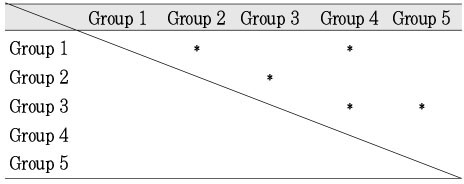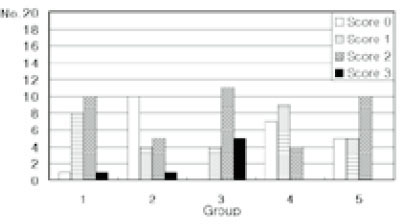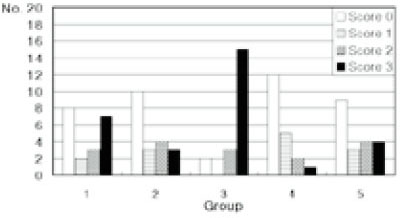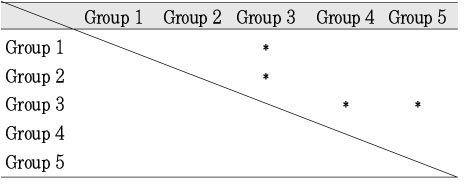Articles
- Page Path
- HOME > Restor Dent Endod > Volume 27(5); 2002 > Article
- Original Article Marginal microleakage of self-etching primer adhesives and a self-etching adhesive
- Young-Gon Cho, Kong-Chul Cho
-
2002;27(5):-501.
DOI: https://doi.org/10.5395/JKACD.2002.27.5.493
Published online: September 30, 2002
Department of Conservative Dentistry, College of Dentistry, Chosun University, Korea.
Copyright © 2002 Korean Academy of Conservative Dentistry
- 776 Views
- 2 Download
- 8 Crossref
Abstract
-
This study evaluated the microleakage performance of four self-etcing primer adhesives(Clearfil SE Bond, Clearfil Liner Bond 2, UniFil Bond, and FL Bond) and one self-etching adhesive(Prompt L-Pop). Class V cavity preparations with occlusal margins in enamel and gingival margins in dentin were prepared on both buccal and lingual surfaces of 50 extracted human molar teeth. Prepared teeth were randomly divided into five groups and restored using one of five adhesives and composite resins: Prompt L-Pop/Filtek Z 250(Group 1), Clearfil SE Bond/Clearfil AP-X(Group 2), Clearfil Liner Bond 2/Clearfil AP-X(Group 3), UniFil Bond/UniFil F(Group 4), and FL Bond/Filtek Z 250(Group 5).Following one day storage in room temperature water, the restored teeth were thermocycled for 500 cycles between 5℃ and 55℃. Marginal microleakage was assessed by dye penetration using 2% methylene blue dye. After 24 hours, the teeth were sectioned longitudinally and evaluated for microleakage under steromicroscope. The data were statistically analysed by Kruskal-Wallis Test, Mann-Whitney and Wilcoxon signed ranked tests.The results of this study were as follows;1. The microleakges at both enamel and dentinal margins were the lowest in group 4, increasing among groups in the following order: group 2, follwed by group 5, follwed by group 1, and the highest in group 3.2. At the enamel margins, the microleakage of group 3 was significantly higher than those of groups 2, 4 and 5(p<0.05), and also the microleakage of group 1 was statistically higher than those of groups 2 and 5(p<0.05).3. At the dentinal margins, microleakage of group 3 was significantly higher than microleakages of groups 1, 2, 4 and 5(p<0.05).4. Compared with microleakages between the enamel and dentinal margins of each group, groups 1, 4 and 5 at enamel margin and group 2 and group 3 at dentinal margin were higher microleakage. But there was no significant difference between enamel and dentinal microleakages of each group(p>0.05).
- 1. Perdigão J, Frankenberger R, Rosa BT, Breschi L. New trend in dentin/enamel adhesion. Am J Dent. 2000;13: 25D-30D.PubMed
- 2. Davidson CL, Degee AJ, Feilzer AJ. The competition between the composite-dentin bond strength and polymeriztion contraction stress. J Dent Res. 1984;63(12):1396-1399.ArticlePubMedPDF
- 3. Choi KK, Condon JR, Ferracane JL. The effects of adhesive thickness on polymerization contraction stress of composite. J Dent Res. 2000;79(3):812-817.ArticlePubMedPDF
- 4. Pradelle-Plasse N, Nechad S, Tavernier B, Colon P. Effect of dentin adhesives on the enamel-dentin/composite interfacial mroleakage. Am J Dent. 2001;14(6):344-348.PubMed
- 5. Bergenholtz G, Cox CF, Loesche WJ, Syed SA. Bacterial leakage around dental restorations: Its effect on the dental pulp. J Oral Pathol. 1982;11(6):439-450.ArticlePubMed
- 6. Brännström M. The cause of post-restorative sensitivity and its prevention. J Endod. 1986;12: 475-481.ArticlePubMed
- 7. Buonocore MC. Simple method of increasing the adhesion of acrylic filling materials to enamel surface. J Dent Res. 1955;34(6):849-853.ArticlePubMedPDF
- 8. Fritz UB, Diedrich P, Finger WJ. Self-etching primers-an alternative to the conventional acid etch technique? J Orofac Orthop. 2001;62(3):238-245.ArticlePubMedPDF
- 9. Hannig M, Reinhardt K-J, Bott B. Self-etching primer vs phosphoric acid: An alternative concept for composite-to-enamel bonding. Oper Dent. 1999;24: 172-180.PubMed
- 10. Bouillaguet S, Gysi P, Wataha JC, Ciucchi B, Cattani M, Godin C, Meyer JM. Bond strength of composite to dentin using conventional, one-step, and self-etching adhesive systems. J Dent. 2001;29(1):55-61.ArticlePubMed
- 11. Frankenberger R, Perdigao J, Rosa BT, Lopes M. "No-bottle" vs "multi-bottle" dentin adhesives-a microtensile bond strength and morphological study. Dent Mater. 2001;17(5):373-380.ArticlePubMed
- 12. Toledano M, Osorio R, de Leonardi G, Rosales-Leal JI, Ceballos L, Cabrerizo-Vilchez MA. Influence of self-etching primer on the resin adhesion to enamel and dentin. Am J Dent. 2001;14(4):205-210.PubMed
- 13. Besnault C, Attal JP. Influence of a simulated oral environment on microleakage of two adhesive systems in Class II composite restorations. J Dent. 2002;30(1):1-6.ArticlePubMed
- 14. Gordan VV, Vargas MA, Cobb DS, Denehy GE. Evaluation of acidic primers in microleakage of class 5 composite resin restorations. Oper Dent. 1998;23: 244-249.PubMed
- 15. Li H, Burrow MF, Tyas MJ. The effect of load cycling on the nanoleakage of dentin bonding systems. Dent Mater. 2002;18(2):111-119.ArticlePubMed
- 16. Yoshiyama M, Urayama A, Kimochi T, Matsuo T, Pashley DH. Comparison of conventional vs self-etching adhesives bonds to caries-affected dentin. Oper Dent. 2000;25: 163-169.PubMed
- 17. Kanca J. Effect of resin primer solvents and surface wetness on resin composite bond strength to dentin. Am J Dent. 1992;5(4):213-215.PubMed
- 18. Nakabayashi N. Dentinal bonding mechanisms. Quintessence Int. 1991;22(2):73-74.PubMed
- 19. Nakabayashi N, Sami Y. Bonding to intact dentin. J Dent Res. 1996;75(9):1706-1715.ArticlePubMedPDF
- 20. Ritter AV, Heymann HO, Swift E Jr, Perdigao J, Rosa BT. Effect of different re-wetting techniques on dentin shear bond strengths. J Esthet Dent. 2000;12: 85-96.PubMed
- 21. Hayakawa T, Kikutake K, Nemoto K. Influence of self-etching primer treatment on the adhesion of resin composite to polished dentin and enamel. Dent Mater. 1998;105: 99-105.Article
- 22. Miyasaka K, Nakabayashi N. Combination of EDTA conditioner and phenyl-P/HEMA self-etching primer for bonding to dentin. Dent Mater. 1999;15(3):153-157.ArticlePubMed
- 23. Ogata M, Nakajima M, Sano H, Tagami J. Effect of dentin primer application on regional bond strength to cervical wedge-shaped cavity walls. Oper Dent. 1999;24(2):81-88.PubMed
- 24. Finger WJ, Ahlstrand WM. 4-META as an acidic monomer in an all-in-one experimental adhesive. Compend Contin Educ Dent. 2001;22: 12 Suppl. 8-11.
- 25. Pontes DG, de Melo AT, Monnerat AF. Microleakage of new all-in-one adhesive systems on dentinal and enamel margins. Quintessence Int. 2002;33(2):136-139.PubMed
- 26. Zheng L, Pereira PNR, Nakajima M, Sano H, Tagami J. Relationship between adhesive thickness and microtensile bond strength. Oper Dent. 2001;26: 97-104.PubMed
- 27. Inoue S, Van Meebeek B, Vargas M, Yoshida Y, Lambrechts P, Vanherle G. Adhesion mechanism of self-etching adhesives. Advanced Adhesive Dentistry 3rd international Kuraray symposium. 1999;131-148.
- 28. Prati C, Pashley DH, Chersoni S, Mongiorgi R. Marginal hybrid layer in class V restorations. Oper Dent. 2000;25: 228-233.PubMed
- 29. Barkmeier WW, Los SA, Triolo PT Jr. Bond strengths and SEM evaluation of Clearfil Liner Bond 2. Am J Dent. 1995;8(6):289-293.PubMed
- 30. Rosa BT, Perdigao J. Bond strengths of nonrinsing adhesives. Quintessence Int. 2000;31: 353-358.PubMed
- 31. Yoshiyama M, Matsuo T, Ebisu S, Pashley D. Regional bond strengths of self-etching/self-priming adhesive systems. J Dent. 1998;26: 609-616.ArticlePubMed
- 32. Kidd EA. Microleakage: A review. J Dent. 1976;4(5):199-206.ArticlePubMed
- 33. Reeves GW, Fitchie JG, Hembree JH Jr, Puckett AD. Microleakage of new dentin bonding systems using human and bovine teeth. Oper Dent. 1995;20(6):230-235.PubMed
- 34. Perdigao J, Lopes L, Lambrechts P. Effects of self-etching primer on enamel shear bond strengths and SEM morphology. Am J Dent. 1997;10: 141-146.PubMed
- 35. Ferrari M, Mannocci F, Vichi A, Davidson CL. Effect of two etching timers on the sealing ability of Clearfil Liner Bond 2 in Class V restorations. Am J Dent. 1997;10(2):66-70.PubMed
- 36. Swift EJ Jr. Self-etching primers: Part I. J Esthet Dent. 2000;12(3):111-113.
- 37. Technical Brief : Unifil Bond, Unifil F composite. 1999;GC Corporation.
- 38. Hotta K, Mogi M, Miura F, Nakabayashi N. Effects of 4-MET on bond strength and penetration monomers into enamel. Dent Mater. 1992;8: 173-175.PubMed
- 39. Kubo S, Yokota H, Sata Y, Hayashi Y. Microleakage of self-etching primers after thermal and flexural load cycling. Am J Dent. 2001;14(3):163-169.PubMed
- 40. Product Dossier: Prompt L-Pop. 1999;ESPE.
- 41. Opdam NJ, Roeters FJ, Feilzer AJ, Verdonschot EH. Marginal integrity and postoperative sensitivity in Class 2 resin composite restorations in vivo. J Dent. 1998;26(7):555-562.ArticlePubMed
- 42. Nishida K, Yamauchi J, Wata T, Hosoda H. Development of a new bonding system. J Dent Res. 1993;72: 137. (IADR, Abstract #267).
- 43. Imazato S, Ebisu S, Tarumi H, Kinomoto Y, Takeshige F. Development of antibacterial adhesive system: efficacy of new self-etching primer containing antibacterial monomer. Advanced Adhesive Dentistry 3rd international Kuraray symposium. 1999;227-239.
- 44. Al-Ehaideb AA, Mohammed H. Microleakage of "one-bottle" dentin adhesives. Oper Dent. 2001;26: 172-175.
- 45. Tulunoglu O, Uctash M, Alacam A, Omurlu H. Microleakage of light-cured resin and resin-modifed glass-ionomer dentin bonding agents applied with co-cure vs pre-cure technique. Oper Dent. 2000;25: 292-298.PubMed
- 46. Santini A, Plasschaert AJ, Mitchll S. Effect of composite resin placement techniques on the microleakage of two self-etching dentin-bonding agents. Am J Dent. 2001;14(3):132-136.PubMed
- 47. Barkmeier WW, Douville CJ, Matranga LF. Shear bond strength, microleakage and scanning electron microscopy study of the Clearfil Liner Bond System. Asian J Aesthet Dent. 1993;1(2):85-90.PubMed
- 48. Hanning M, Fu B. Effect of air abrasion and resin composite on microleakage of Class V restorations bonded with self-etching primers. J Adhes Dent. 2001;3: 265-272.PubMed
REFERENCES


Tables & Figures
REFERENCES
Citations

- Effect of cutting instruments on the dentin bond strength of a self-etch adhesive
Young-Gon Lee, So-Ra Moon, Young-Gon Cho
Journal of Korean Academy of Conservative Dentistry.2010; 35(1): 13. CrossRef - Comparison of bond strength of a fiber post cemented with various resin cements
Hyun-A Lee, Young-Gon Cho
Journal of Korean Academy of Conservative Dentistry.2008; 33(6): 499. CrossRef - Enamel adhesion of light- and chemical-cured composites coupled by two step self-etch adhesives
Sae-Hee Han, Eun-Soung Kim, Young-Gon Cho
Journal of Korean Academy of Conservative Dentistry.2007; 32(3): 169. CrossRef - Effect of microleakage of a self-etching primer adhesive according to types of cutting instruments
Yong-Hee Kim, Jae-Gu Park, Young-Gon Cho
Journal of Korean Academy of Conservative Dentistry.2007; 32(4): 327. CrossRef - Influence of appication time of self-etching primers on dentinal microtensile bond strength
Young-Gon Cho, Young-Gon Lee, Jong-Uk Kim, Byung-Cheul Park, Jong-Jin Kim, Hee-Young Choi, Cheul-Hee Jin, Sang-Hoon Yoo
Journal of Korean Academy of Conservative Dentistry.2004; 29(5): 430. CrossRef - Morphological patterns of self-etching primers and self-etching adhesive bonded to tooth structure
Young-Gon Cho, Seok-Jong Lee, Jin-Ho Jeong, Young-Gon Lee, Soo-Mee Kim
Journal of Korean Academy of Conservative Dentistry.2003; 28(1): 23. CrossRef - Shear bond strength of self-etching adhesives to dentin and sem analysis
Young-Gon Cho, Kee-Sun Roh, Soo-Mee Kim, Young-Gon Lee, Jin-Ho Jeong, Young-Jae Ki
Journal of Korean Academy of Conservative Dentistry.2003; 28(3): 222. CrossRef - The effect of additional enamel etching on microleakage of the adhesion of self-etching primer system
Jung-Jin Yoon, Kyung-San Min, Chan-Ui Hong
Journal of Korean Academy of Conservative Dentistry.2003; 28(5): 363. CrossRef


Fig. 1
Fig. 2
Group classification and self-etching primer adhesives and self-etching adhesive/composite resins used in this study
*: Manufacturers of adhesive and composite resin are not same in Group 5.
Distribution of microleakage scores and means at enamel margins
Distribution of microleakage scores and means at dentin margins
Statistical analysis of microleakage at enamel margin between each group by Mann-Whitney test
*: significant differences (p<0.05)
Statistical analysis of microleakage at dentin margin between each group by Mann-Whitney test
*: significant differences (p<0.05)
Statistical analysis of microleakage at enamel and dentin margin between each group by Wilcoxon signed rank sum test
-: no-significant differences(p>0.05)
*: Manufacturers of adhesive and composite resin are not same in Group 5.
*: significant differences (p<0.05)
*: significant differences (p<0.05)
-: no-significant differences(p>0.05)

 KACD
KACD






 ePub Link
ePub Link Cite
Cite

